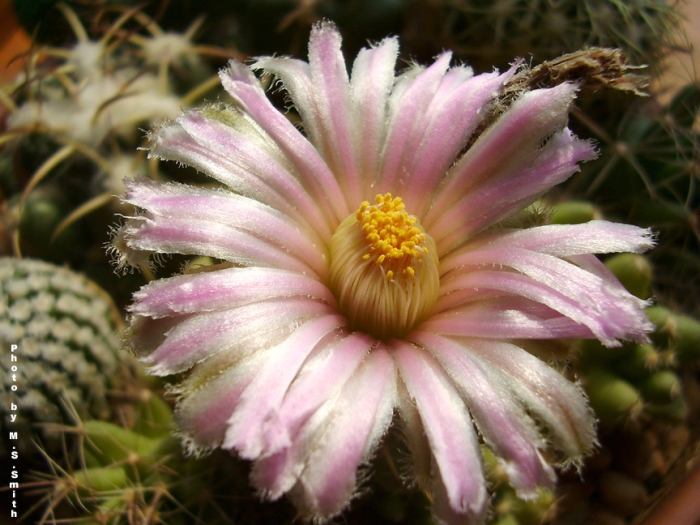Nipple Beehive Cactus
(Coryphantha macromeris)
Nipple Beehive Cactus (Coryphantha macromeris)
/
/

msscacti
CC BY 2.0
Image By:
msscacti
Recorded By:
Copyright:
CC BY 2.0
Copyright Notice:
Photo by: msscacti | License Type: CC BY 2.0 | License URL: https://creativecommons.org/licenses/by-sa/2.0/ | Uploader: msscacti | Publisher: Flickr |























































Estimated Native Range
Summary
Coryphantha macromeris, commonly known as Nipple Beehive Cactus, is an evergreen succulent native to arid regions, rocky slopes, and desert grasslands of the Southwestern United States and Mexico. It is a small cactus, reaching a height of 0.5 feet (0.2 meters) and a width of 0.2-0.3 feet (0.06-0.09 meters). This cactus is characterized by its globular to cylindrical stems covered in tubercles, which give it a beehive appearance, and the areoles at the tubercle tips resemble nipples, hence the common name. The Nipple Beehive Cactus blooms in late summer, producing showy purple or pink flowers that are followed by green fruit.
The Nipple Beehive Cactus is valued for its unique form and attractive flowers, making it a popular choice for rock gardens, xeriscaping, and as a potted specimen for enthusiasts of drought-tolerant plants. It requires minimal maintenance and thrives in full sun with very low to low water needs, preferring well-draining sandy or gravelly soils. While it is often said to prefer shade, this cactus does well in sunny locations, provided it has some protection during the hottest part of the day in extremely hot climates. It is not prone to many diseases but can suffer from root rot if overwatered.CC BY-SA 4.0
The Nipple Beehive Cactus is valued for its unique form and attractive flowers, making it a popular choice for rock gardens, xeriscaping, and as a potted specimen for enthusiasts of drought-tolerant plants. It requires minimal maintenance and thrives in full sun with very low to low water needs, preferring well-draining sandy or gravelly soils. While it is often said to prefer shade, this cactus does well in sunny locations, provided it has some protection during the hottest part of the day in extremely hot climates. It is not prone to many diseases but can suffer from root rot if overwatered.CC BY-SA 4.0
Plant Description
- Plant Type: Succulent
- Height: 0.25-0.3 feet
- Width: 1-1.5 feet
- Growth Rate: Slow
- Flower Color: Yellow
- Flowering Season: Summer, Fall
- Leaf Retention: Evergreen
Growth Requirements
- Sun: Full Sun
- Water: Very Low, Low
- Drainage: Fast
Common Uses
Drought Tolerant, Low Maintenance
Natural Habitat
native to arid regions, rocky slopes, and desert grasslands of the Southwestern United States and Mexico
Other Names
Common Names: Biznaga-Partida Partida
Scientific Names: , Coryphantha macromeris,
GBIF Accepted Name: Coryphantha macromeris (Engelm.) Britton & Rose